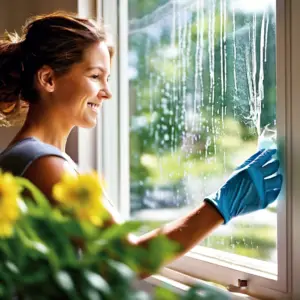May Home Maintenance Checklist
May Home Maintenance Tips
Getting your grill ready for May and the upcoming grilling season involves a comprehensive maintenance checklist to ensure safety, enhance performance, and prolong the life of your grill. Whether you have a gas or charcoal grill, follow these steps to prepare your grill for the season:
1. For Both Gas and Charcoal Grills
Inspect and Clean the Grill  Grates
Grates
Remove the grates and soak them in a mixture of warm water and degreaser to loosen the grime.
Use a wire brush or grill stone to scrub the grates clean after soaking.
For stainless steel grates, avoid using a wire brush; instead, opt for a nylon brush or a ball of aluminum foil.
Lightly coat the grates with cooking oil and heat the grill to a high temperature for about 15-20 minutes to create a non-stick surface and prevent rust.
Clean the Interior
For charcoal grills, remove ashes and debris from the bottom of the grill.
For gas grills, clean the burners, flame tamers, and other interior parts with soapy water. Check and clean the venturi tubes to ensure they are clear of obstructions.
Check for Wear and Damage
Inspect all parts of the grill for signs of wear, rust, or damage. Replace any parts as necessary.
For gas grills, check the fuel lines for cracks and leaks using a soap and water solution. Replace the line if leaks are found.
Exterior Cleaning
Clean the grill’s exterior with soapy water. For stainless steel surfaces, you can use a specialized cleaner or polish the surface with a lubricant like WD-40 to brighten it.
Safety and Functionality Check
For gas grills, reconnect the propane tank and check for gas leaks using a soap and water solution.
Light the grill and let it run for a few minutes to ensure everything is functioning correctly and there are no issues with gas flow or air circulation.
Protective Measures
Use a grill cover to protect your grill from the elements when not in use. However, if you live in a humid area or near the ocean, it might be better to leave the grill uncovered to avoid trapping moisture that could cause rust.
Stock Up on Supplies
Ensure you have enough fuel for the season, whether it’s propane for gas grills or charcoal for charcoal grills.
Check your grilling tools and accessories, such as tongs, spatulas, and cleaning brushes, and replace any that are worn out.
By following these steps, you’ll ensure your grill is clean, safe, and ready for the grilling season. Regular maintenance not only helps prevent potential hazards but also improves the performance of your grill, making your outdoor cooking experiences more enjoyable.
Active Cross Creek Homes For Sale
2. Wash and Inspect the Exterior Of The Home

Inspect Patios and Walkways
Check for any cracks or uneven surfaces that may need repair. This can prevent tripping hazards and further deterioration.
Clean the Gutters
Remove any debris from the gutters to prevent water damage and ensure proper drainage.
Consider using a ladder, garden hose, or specialized tools like a gutter scoop to effectively clean out the gutters.
Wash Exterior Windows
Clean the windows to not only improve the appearance of your home but also enhance natural lighting inside.
Use a mixture of water and vinegar or a professional window cleaning solution and a squeegee for the best results.
Check and Repair Fences and Gates
Look for any damage or wear in your fencing and gates. Repair or replace parts as necessary to maintain security and aesthetics.
Service Your AC Unit
While not directly related to washing, ensuring your AC unit is serviced and clean is crucial before the summer heat.
Power Wash Siding and Decks
Use a power washer to clean the siding of your house and decking areas. This not only removes dirt and grime but can also prevent mold and mildew buildup.
Be cautious with the pressure settings to avoid damaging the siding or wood.
Inspect and Clean Roof
Look for any missing, loose, or damaged shingles and check for leaks.
Remove any debris or moss that can retain moisture and cause roof damage. Get a Free Roof Inspection with All Out Roofing, LLC
Mulch Flower and Vegetable Beds
While mulching is more about gardening, it also contributes to the overall cleanliness and maintenance of your home’s exterior by preventing weed growth and enhancing the appearance of your garden areas.
Inspect and Clean Downspouts
Ensure that downspouts are directing water away from the foundation of your house to prevent water damage.
Flush them with water to check for and clear any blockages.
Check Exterior Paint and Touch Up
Inspect the paint on your home’s exterior; look for chipping or peeling areas.
Touch up or repaint areas as needed to protect the material underneath and boost curb appeal.
By following these steps, you can effectively maintain the exterior of your home in May, ensuring it remains in good condition and looks its best. Regular maintenance like this not only preserves the appearance and functionality of your home but can also prevent costly repairs in the future.
3. Washing Windows
Another May home maintenance tip focused on washing windows, the following methods and solutions from the provided sources can help you achieve clean, streak-free windows:
Vinegar and Soap Solution 
Architectural Digest recommends using a white vinegar or soap solution for cleaning windows. After applying the solution, dry the window with a squeegee, moving from the top of the window with the squeegee blade angled toward the bottom. Reinstall the window screens afterward.
Vinegar, Water, and Dish Detergent
She Wears Many Hats suggests a mixture of 2 cups water, 1/4 cup white vinegar, and 1/2 teaspoon dish detergent. Use a soft bristle scrub brush on an extension pole to apply the solution, then rinse it off with clean water before it has a chance to dry.
Castile Soap and Water
Homes and Gardens offers a quick 2-ingredient recipe using one tablespoon of Castile soap in one liter of distilled water. This solution can be used both inside and outside the windows and is particularly effective for making your home smell nice if you choose a scented soap.
Ammonia and Rubbing Alcohol
HowStuffWorks provides a recipe that includes 2 tablespoons ammonia, 1/2 cup rubbing alcohol, and 1/4 teaspoon dishwashing liquid. This mixture is effective for cleaning windows and leaving them streak-free.
Dishwashing Detergent
This Old House recommends a simple solution of clean water with a small amount of liquid dishwashing detergent. After applying the solution, clean the glass with a scrubber and then dry it with a squeegee.
Additional Tips:
Bob Vila advises cleaning windows on a cloudy day to prevent the cleaning solution from drying too quickly, which can lead to streaks.
CNN Underscored emphasizes the importance of identifying if your glass windows or doors have special glass coatings before cleaning, as certain cleaners and tools may damage these coatings.
By combining these methods and solutions, you can effectively wash your windows as part of your May home maintenance, ensuring they are clean and streak-free. Remember to choose the solution that best suits your needs and the specific conditions of your windows.
4. Clean Out Gutters
Cleaning gutters and managing water flow around your home are crucial aspects of home maintenance, especially in preparation for the rainy season. Here’s a comprehensive guide based on the provided sources:
Cleaning Gutters
Safety First: Before starting, ensure you have a sturdy ladder, gloves to protect your hands, and safety goggles or glasses. Consider using a ladder stabilizer for added safety.
Remove Debris: Begin by removing leaves, twigs, and any other debris from the gutters. This can be done by hand, with a gutter scoop, or a small plastic shovel.
Flush Gutters with Water: After removing the debris, use a garden hose to flush the gutters. This helps remove any remaining dirt and checks if the gutters are draining properly.
Check Downspouts for Clogs: If water isn’t flowing freely, the downspouts may be clogged. To clear them, you can use a plumber’s snake or a high-pressure hose nozzle.
Inspect for Damage: While cleaning, inspect your gutters for any signs of damage, such as holes, rust, or sections that are sagging or detached. Repair or replace damaged sections as necessary.
Managing Water Flow
Ensure Proper Slope:
Gutters should slope towards downspouts to prevent water pooling. The general rule is a slope of 1/4 inch for every 10 feet of gutter.
Extend Downspouts:
Downspouts should extend at least 5 feet away from your home’s foundation to prevent water damage. Use downspout extenders if necessary.
Install Gutter Guards:
Gutter guards can prevent debris from entering the gutters, reducing the frequency of cleaning and the risk of clogs.
Create a Rain Garden or Use Rain Barrels:
To manage excess water, consider installing rain barrels to collect runoff or create a rain garden. Rain gardens are designed to absorb and filter runoff water, while rain barrels can store water for garden use.
Check Landscaping and Grading:
Ensure the ground slopes away from your home’s foundation to prevent water from pooling around it. Adjust landscaping as necessary to improve drainage.
Inspect and Repair Foundation Drains:
If your home has foundation drains or a sump pump, inspect them to ensure they are functioning correctly. Clean and repair any parts as needed.
By following these May home maintenance steps for cleaning gutters and managing water flow, you can protect your home from water damage, prevent basement flooding, and maintain the integrity of your home’s foundation. Regular maintenance, especially before the rainy season, is key to avoiding costly repairs in the future.
Check Outdoor Lighting
Checking outdoor lighting is an essential part of your May home maintenance checklist. Properly functioning outdoor lighting enhances the aesthetic appeal of your home, improves safety by illuminating walkways, and increases security by deterring potential intruders. Here’s a step-by-step guide to ensure your outdoor lighting is in top condition:
Inspect Light Fixtures
Visual Inspection: Walk around your property in the daylight and visually inspect all outdoor light fixtures for any signs of damage, such as cracked housings or broken lenses.
Clean Fixtures: Remove any debris, dirt, or cobwebs from the fixtures. For glass components, use a gentle cleaner and a soft cloth to avoid scratching the surface.
Check Bulbs and Replace if Necessary
Test Light Bulbs: Turn on all outdoor lights to identify any that are not working. It’s helpful to do this at dusk when it’s easier to see which bulbs need replacing.
Upgrade to LED: Consider replacing incandescent bulbs with LED bulbs. LEDs are more energy-efficient, have a longer lifespan, and can withstand temperature fluctuations better, making them ideal for outdoor use.
Assess Lighting Placement and Effectiveness
Evaluate Coverage: Ensure that all areas that require illumination, such as walkways, driveways, entryways, and security-sensitive areas, are adequately lit.
Adjust Fixtures: Reposition any lights that are not effectively illuminating their intended areas. This may involve adjusting the angle of the light or relocating the fixture.
Check Electrical Components
Inspect Wiring: Look for any exposed or damaged wiring that could pose a safety hazard. If you’re not comfortable assessing electrical components, consider hiring a professional electrician.
Test Motion Sensors and Timers: If your outdoor lighting is equipped with motion sensors or timers, test them to ensure they are functioning correctly. Adjust settings as needed for optimal performance.
Solar Lights Maintenance
Clean Solar Panels: For solar-powered lights, clean the solar panels with a damp cloth to ensure they can efficiently absorb sunlight.
Check Battery Life: Solar lights have rechargeable batteries that may need to be replaced every 1-2 years, depending on usage and exposure to elements.
Safety Precautions
Turn Off Power: Before performing any maintenance on hardwired outdoor lighting fixtures, ensure the power is turned off at the circuit breaker to prevent electrical shock.
Use Proper Ladder Safety: When accessing high fixtures, use a stable ladder and follow proper safety protocols to prevent falls.
By following these May home maintenance steps, you can ensure your outdoor lighting is ready for the longer evenings and increased outdoor activity that comes with the warmer months. Regular maintenance not only extends the life of your lighting fixtures but also enhances the overall safety and security of your home.
Inspect and clean air conditioning units
Inspecting and cleaning your air conditioning (AC) units is a crucial task to ensure they operate efficiently, especially as you prepare for the warmer months. Here’s a comprehensive guide to help you with this process:
Safety First
- Turn Off Power: Before you start any work on your AC unit, ensure the power is turned off at the breaker box to prevent any accidents.
External Unit Maintenance
Inspect the Unit: Check the outdoor unit for any visible signs of damage, such as bent fins, cracks, or rust. Also, ensure there’s at least 2 feet of clearance around the unit for proper airflow.
Clean the Exterior: Remove any leaves, dirt, and debris from the top and sides of the unit. You can use a garden hose to gently wash away dirt, but avoid using a pressure washer as it can damage the fins.
Straighten the Fins: Bent fins can restrict airflow. Carefully straighten any bent fins using a fin comb or a small flat-head screwdriver.
Check Refrigerant Lines: Inspect the refrigerant lines running from the outdoor unit to the house. They should be insulated to maintain efficiency. Replace any damaged insulation as needed.
Indoor Unit Maintenance
Change the Air Filter: A dirty air filter can reduce airflow and efficiency. Replace it with a new one every 1-3 months, depending on usage and the type of filter.
Clean the Evaporator Coil: The indoor unit’s evaporator coil can collect dust and dirt, reducing efficiency. Clean it with a soft brush and coil cleaner, following the manufacturer’s instructions.
Inspect the Condensate Drain: The condensate drain can become clogged, leading to water damage and increased humidity levels. Check the drain for clogs and clear it if necessary. You can use a mixture of bleach and water to prevent algae growth.
Check Electrical Connections: Look for any loose electrical connections. If you’re not comfortable working with electrical components, consider hiring a professional to do this.
Professional Maintenance
Annual Service: Even with regular self-maintenance, it’s a good idea to have your AC system serviced by a professional at least once a year. They can perform a more thorough inspection, address any issues, and ensure the system is running at peak efficiency.
Additional Tips
Thermostat Settings: Check your thermostat settings to ensure they are appropriate for the season. Consider upgrading to a programmable thermostat if you haven’t already, as it can help save energy by adjusting the temperature when you’re not home.
Check Ductwork: Inspect visible ductwork for any signs of leaks, such as holes or separated joints. Sealing leaks can significantly improve efficiency and performance.
By following these May home maintenance steps, you can ensure your air conditioning units are clean, efficient, and ready to keep you cool during the warmer months. Regular maintenance not only extends the life of your AC units but also helps reduce energy costs and prevent unexpected breakdowns.
























